Tentative Tasks
- 2 data sets: (1) 8-ch newborn EEG data, that are effectively only 6 channels due to the connection of electrodes, not containing any obvious artifact and (2) an artificial data that represent artifacts of different kind: unleaped electrode, eye blinking (see figures below)
- Task: To blindly separate the data and the artifacts from their sum. It is a hard problem because of a small available number of channels and high number of artifacts.
- Functionality of the removal will be verified by using a different but similarly looking artifacts.
Test data
The data from aktive sleep of a newborn individual were sampled at 128 Hz and have total length of 2 minutes. There is a mutual dependence within the first four channels and also within the last four channels due to montage of electrodes, so that only 6 channels of 8 are really independent. It is a practical problem.
The data (in matlab format) can be downloaded from http://si.utia.cas.cz/data.mat
The contains separately artifact and clean data, denoted a and x. The task is to blindly separate a and x from a+x. This is one task. Participants should send us their best separation x_hat that minimizes the norm (x_hat - x).
Of course, only a+x should be available to the program.
Data:

Artifacts:

Task data and submission
The task dataset can be downloaded from:http://si.utia.cas.cz/CompetitionData.mat
The separation task is similar to the test data but her only y = x + a is given.
[SUBMISSION CLOSED on Apr.21]
Participants should send their estimate of x. The format of the data should be preferably matlab .mat or ascii in columns
and can be send via email to: p(dot)tichavsky (at) ieee(dot)org
Evaluation Criteria
We measure the Euclidean distance between the original and the reconstructed data.
Reference software
Software to visualize the outcome – is helpful, we use eegplot from Eeglab by Makeig et al.
Potential participants
Ricardo Vigario,
Scott Makeig
German Gomez-Herrero?
Stefan Haufe
Petr Tichavsky
Saeid Sanei
Task proposed by Petr Tichavsky
